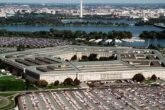December 14, 2021
How the U.S. Can Quickly Build Greater Resiliency in Space
Vice President Harris’s chairmanship of the first National Space Council under the Biden administration earlier this month is a welcome step toward a whole-of-government approach for securing the space domain for the U.S. economy, military and civil society. Such an approach is urgently needed, as the last two months have shown: China conducted a hypersonic glide vehicle test and Russia created thousands of pieces of debris through an anti-satellite missile test.
The enabling policy framework released by the space council directs the Department of Defense to “accelerate its transition to a more resilient national security space posture.” While this direction is welcome in the halls of the Pentagon, the devil is in the details – and there are plenty of them when it comes to manifesting broad policy guidance into architectural solutions that are programmed for DoD and funded by Congress.
China and Russia will continue to pose significant threats to our space systems, from cyber intrusion techniques to kinetic destructive ASAT tests.
As leaders across government work through these details, here are several principles they should embrace.
Speed to development
Speed is a critical element of success in this enterprise. Endowed with a congressional mandate to “go fast” in space acquisition, the Space Force is showing signs of living up to that charge. The Next-Generation Overhead Persistent Infrared missile-warning system just passed a critical design review. The Space Development Agency (SDA) continues to innovate and instantiate new architectural concepts, support new foundational technologies necessary for resilient space architectures as witnessed by their investment in optical intersatellite links, and find ways to work with nontraditional companies making space entries. Meanwhile, the Space Enterprise Consortium known as SpEC OTA continues to grow both in membership and funding profiles to the benefit of Space Systems Command and the space industrial base.
Read the full article from Space News.
More from CNAS
-
The Department of Defense’s Breakthrough Nuclear Moment Risks Slipping Away
Unless they act, the Department of Defense’s breakthrough nuclear moment may vanish before it really happens....
By Will Rogers
-
DEFAERO Strategy Series [Apr 09, 25] CNAS' Becca Wasser and Phil Sheers on Revitalizing the U.S. Defense Industrial Base
On this episode of the Defense & Aerospace Report Strategy Series, sponsored by General Atomics Aeronautical Systems, Becca Wasser and Phil Sheers of the Center for a New Amer...
By Becca Wasser & Philip Sheers
-
From Production Lines to Front Lines
Executive Summary The U.S. defense industrial base (DIB) is struggling to meet the demands of the current strategic environment—let alone prepare for a potential conflict agai...
By Becca Wasser & Philip Sheers
-
The Pentagon’s Endangered Brain Trust
In this environment, sound assessments of emerging threats and new ideas to counter them will be especially vital....
By Dr. Andrew Krepinevich, Jr.




